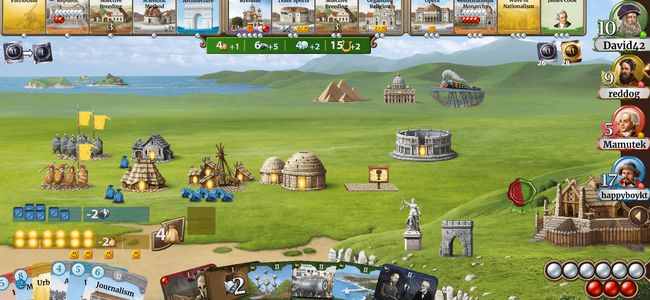The yellow bank is carefully designed to show the relations between population, land ,food consumption and require of happiness. However, I feel like the concepts in it are too abstract for a lot of players.
Yellow Bank Explained
Q1: Overall, what is the yellow bank about?
A1: The game needs some way to show the relations among population,land, food consumption and happiness. In real life, there might be some formula to calculate. But the game uses the yellow bank to show them all.
Q2: What does increasing your population(taking a token from the yellow bank) imply.
A2: The tokens represent open land. So incresing the population takes away some open land, leading to higher density.
Q3: Why do you need more food consumption when you take away yellow tokens?
A3: As Q2 says, yellow tokens represent open land. So less open land, higher density. When there are few people, you can get food from the land(think about ancient tribes, they don’t necessarily need agriculture).But this doesn’t work when there are too much people on the same piece of land, you need extra food production.
Q4: Why do you need more happy faces when you take away yellow tokens?
A4: As Q2 says, yellow tokens represent open land. So less open land, higher density.So as you make more people work in crowded cities, people are going to be a little bit unhappy.(I guess this has something to do with the increase of stress when you interact with more people.)So you need more happy faces.
Q5: Why does spending food increase population?
A5: this might be the toughest question. My best guess is that plenty of food encourages people to raise children(It might not be a good idea to have a child during famine).
Q6: what does the event card “Uncertain Borders” do?
A6: The strongest civilization steels some border land from the weakest. As Q2 says, yellow tokens represent open land.And it makes sense. With less open land(yelloe tokens), the weakest civilization is more likely to have a higher density. And higher density means more food consumptuon and more furious people.Normally, the first 6 population requires 2 happy faces to make them content. If one of your yellow token gets stolen, you need 2 happy faces for the first 5 population.Same for food consumption.
Q7: What does “vast territory” give you?
A7: A lot of open land. This gives you yellow tokens. Your population density immediately drops because you get a lot of open land for the same population. And the drop in density leads to more natural resourses(you get more food from the wild, as said in Q3), and less discontent people(people no longer have to live in crowded land).Also, vast land can lead to problems with governing, so you lose a blue token(more likely to corrupt).
Q8: What does “inhabitant territory” give you?
A8: Also a lot of open land.(inhabitant territory II gives the same amount of land as vast territory I, which is 3 yellor tokens).So it also relieves some density, but it doesn’t help that much since the territory is already inhabitted. So it’s like getting a colony already with natives on it. You can use them as workers(instant population increase), and you get some open land as well(in both inhabitant territory I and II,1 yellow token is added to your bank).
Q9: Why do you lose yellow tokens when you enter age II and III?
A9: This represents the need of better life from people. Modern people consume more and better food(in fact, 40% of food is wasted globally).And people are more aware of their rights, they want more entertainment and satisfaction.Taking 2 yellow tokens means you need more happy faces and consumes more food, perfectly turning this complex calculation simple.
Q10: Are tokens in the yellow bank and tokens in play the same?
A10: No. Tokens in the yellow bank represents open land.Tokens in play represent workers.
